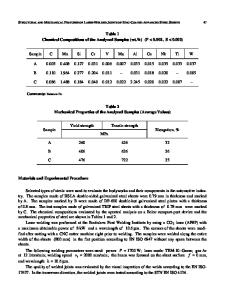Microstructure and mechanical properties of fiber laser welded joints of ultrahigh-strength steel 22MnB5 and dual-phase
- PDF / 1,209,000 Bytes
- 11 Pages / 584.957 x 782.986 pts Page_size
- 55 Downloads / 559 Views
Shang-Lei Yang College of Materials Engineering, Shanghai University of Engineering Science, Shanghai 201620, China; and Shanghai Research and Development Center for Key Technologies of Intelligent Equipments of Ultra-intense Laser Processing (Shanghai University of Engineering Science), Shanghai 201620, China
Wei-Yuan Ni and Jian-Ying Bai College of Materials Engineering, Shanghai University of Engineering Science, Shanghai 201620, China (Received 14 June 2014; accepted 4 September 2014)
This study was to analyze the microstructure, microhardness, tensile and fatigue performance of the welded joints performed by a fiber laser on 22MnB5 and dual-phase steels (DP590, DP980) in similar and dissimilar combinations. The result shows that the weld zone (WZ) basically consisted of lath martensite. The HAZ in these steels can be divided into 3 parts: quenched, incomplete quenched, and tempered region. The WZ had the highest hardness, and a soft zone existed in the HAZ of all steels. Inside the WZ of the dissimilar welded joints, two hardness subregions were observed due to the difference in the alloying elements of these steels. Tensile specimens of the 22MnB5–22MnB5 and 22MnB5–DP980 welded joints were all broken in HAZ, while the 22MnB5–DP590 welded joints failed in the DP590 base metal (BM). The BM had a higher fatigue life than the welded joints, and the fatigue failure of the 22MnB5 similar and 22MnB5–DP980 dissimilar welded joints respectively occurred in the HAZ and DP980 BM. The fatigue fracture contained 3 parts: crack initiation, crack propagation, and the final fast fracture region.
I. INTRODUCTION
Welding is a primary manufacturing process used in many industrial sectors, and it is important to understand the mechanical and metallurgical phenomena concerned to the welding. Laser welding is a new-type technology which is high-energy-density, fast, and precise in joining various materials with different thicknesses and types. 1–3 In the present automotive industry, there is a growing interest in laser welding technology for joining new materials to meet the increasing demand of corrosion resistant, lightweight, and durable autobody parts. To reduce the consumption of materials and fuel as well as the weight of body in white, laser welded blank (LWB) which can weld two or more sheets having different thicknesses or mechanical properties together has been widely used in automotive manufacturing. With the demand for lightweight and safety, advanced high strength steels (AHSSs) are widely applied in automotive industry. Especially, the hot stamping boron steel (B) such as 22MnB5 with a fully martensitic a)
Address all correspondence to this author. e-mail: [email protected] DOI: 10.1557/jmr.2014.273 J. Mater. Res., Vol. 29, No. 21, Nov 14, 2014
http://journals.cambridge.org
Downloaded: 14 Mar 2015
microstructure and the highest strength among the present AHSSs has played an important role in the automobile components and safety parts such as B-pillars and bumpers. 4–6 Dual-phase (DP) steel is also one of the popul
Data Loading...











